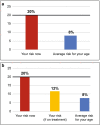Perceived cardiovascular disease risk and tailored communication strategies among rural and urban community dwellers in Rwanda: a qualitative study
- PMID: 35534821
- PMCID: PMC9088034
- DOI: 10.1186/s12889-022-13330-6
Perceived cardiovascular disease risk and tailored communication strategies among rural and urban community dwellers in Rwanda: a qualitative study
Abstract
Background: In Rwanda, cardiovascular diseases (CVDs) are the third leading cause of death, and hence constitute an important public health issue. Worldwide, most CVDs are due to lifestyle and preventable risk factors. Prevention interventions are based on risk factors for CVD risk, yet the outcome of such interventions might be limited by the lack of awareness or misconception of CVD risk. This study aimed to explore how rural and urban population groups in Rwanda perceive CVD risk and tailor communication strategies for estimated total cardiovascular risk.
Methods: An exploratory qualitative study design was applied using focus group discussions to collect data from rural and urban community dwellers. In total, 65 community members took part in this study. Thematic analysis with Atlas ti 7.5.18 was used and the main findings for each theme were reported as a narrative summary.
Results: Participants thought that CVD risk is due to either financial stress, psychosocial stress, substance abuse, noise pollution, unhealthy diets, diabetes or overworking. Participants did not understand CVD risk presented in a quantitative format, but preferred qualitative formats or colours to represent low, moderate and high CVD risk through in-person communication. Participants preferred to be screened for CVD risk by community health workers using mobile health technology.
Conclusion: Rural and urban community members in Rwanda are aware of what could potentially put them at CVD risk in their respective local communities. Community health workers are preferred by local communities for CVD risk screening. Quantitative formats to present the total CVD risk appear inappropriate to the Rwandan population and qualitative formats are therefore advisable. Thus, operational research on the use of qualitative formats to communicate CVD risk is recommended to improve decision-making on CVD risk communication in the context of Rwanda.
Keywords: Cardiovascular disease; Communication strategies; Perceived risk; Rwanda.
© 2022. The Author(s).
Conflict of interest statement
The authors declare that they have no competing interests.
Figures
Similar articles
-
Community Health Worker-Led Cardiovascular Disease Risk Screening and Referral for Care and Further Management in Rural and Urban Communities in Rwanda.Int J Environ Res Public Health. 2023 Apr 25;20(9):5641. doi: 10.3390/ijerph20095641. Int J Environ Res Public Health. 2023. PMID: 37174161 Free PMC article.
-
Multi-country collaborative citizen science projects to co-design cardiovascular disease prevention strategies and advocacy: findings from Ethiopia, Malawi, Rwanda, and South Africa.BMC Public Health. 2023 Dec 12;23(1):2484. doi: 10.1186/s12889-023-17393-x. BMC Public Health. 2023. PMID: 38087240 Free PMC article.
-
Implementing and Evaluating Community Health Worker-Led Cardiovascular Disease Risk Screening Intervention in Sub-Saharan Africa Communities: A Participatory Implementation Research Protocol.Int J Environ Res Public Health. 2022 Dec 24;20(1):298. doi: 10.3390/ijerph20010298. Int J Environ Res Public Health. 2022. PMID: 36612620 Free PMC article.
-
Matters of the heart: cardiovascular disease and rural nursing.Annu Rev Nurs Res. 2008;26:41-84. Annu Rev Nurs Res. 2008. PMID: 18709746 Review.
-
Cardiovascular disease risk communication: Strategies, impact, and future directions.Curr Probl Cardiol. 2024 May;49(5):102490. doi: 10.1016/j.cpcardiol.2024.102490. Epub 2024 Feb 28. Curr Probl Cardiol. 2024. PMID: 38417473 Review.
Cited by
-
A systematic review of health communication strategies in Sub-Saharan Africa-2015-2022.Health Promot Perspect. 2023 Apr 30;13(1):10-20. doi: 10.34172/hpp.2023.02. eCollection 2023. Health Promot Perspect. 2023. PMID: 37309431 Free PMC article.
-
Comparing Machine Learning Classifiers for Predicting Hospital Readmission of Heart Failure Patients in Rwanda.J Pers Med. 2023 Sep 18;13(9):1393. doi: 10.3390/jpm13091393. J Pers Med. 2023. PMID: 37763160 Free PMC article.
-
Cardiovascular disease risk perception among community-dwelling adults in southwest Nigeria: A mixed-method study.PLoS One. 2024 Nov 12;19(11):e0313578. doi: 10.1371/journal.pone.0313578. eCollection 2024. PLoS One. 2024. PMID: 39531473 Free PMC article.
-
The Burden of Cardiovascular Disease from Air Pollution in Rwanda.Ann Glob Health. 2024 Jan 8;90(1):2. doi: 10.5334/aogh.4322. eCollection 2024. Ann Glob Health. 2024. PMID: 38223653 Free PMC article.
-
Effects of message framing and risk perception on health communication for optimum cardiovascular disease primary prevention: a protocol for a multicenter randomized controlled study.Front Public Health. 2024 Mar 14;12:1308745. doi: 10.3389/fpubh.2024.1308745. eCollection 2024. Front Public Health. 2024. PMID: 38550324 Free PMC article.
References
-
- Rwanda Ministry of Health, “Rwanda Non-communicable Diseases Risk Factors Report,”https://www.who.int/ncds/surveillance/steps/Rwanda_2012_STEPS_Report.pdf [Accessed on 12 Dec 2020], Kigali, 2015.
-
- National Institutute of Statistics of Rwanda (NISR), Ministry of Health (MOH) [Rwanda], and ICF International, “Rwanda Demographic and Health Survey 2014–2015.”. Available: https://dhsprogram.com/pubs/pdf/FR316/FR316.pdf.
-
- National Institutute of Statistics of Rwanda(NISR), “Rwanda Vital Statistics Report 2020.”. Available: https://www.statistics.gov.rw/publication/1705.
Publication types
MeSH terms
LinkOut - more resources
Full Text Sources





